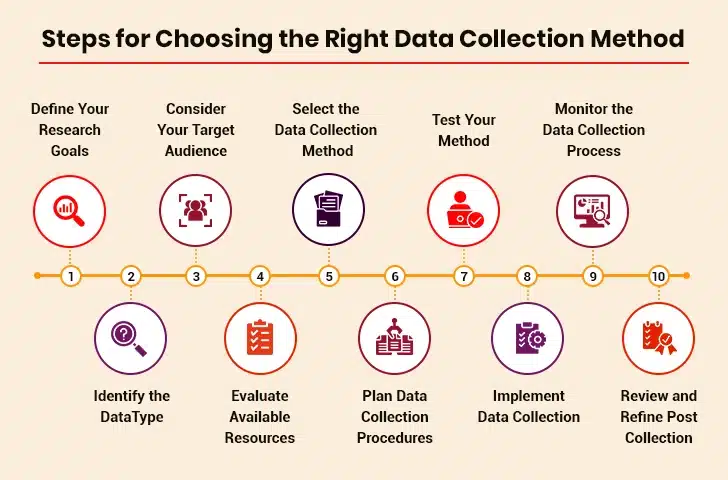Data serves as a rich source of valuable information that helps you make better decisions. Whether you’re a business trying to understand your customers or a researcher looking to solve a problem, collecting data is the first step. Over time, the way data is collected has changed a lot. In the past, data was collected primarily through surveys and interviews. With technological advancements, you have many more options to collect data. In this article, we’ll explore all these methods, from simple surveys to advanced sensor-driven techniques and how they help enterprises in achieving goals faster.

Table of Contents
Traditional Data Collection Methods
Modern Digital Data Collection Techniques
Steps for Choosing the Right Data Collection Method
Traditional Data Collection Methods
Traditional methods of data collection include questionnaires and surveys, interviews, observations, focus groups, and documents and records. Here’s a more detailed look at each method:
1. Interviews
| Pros | Cons |
|---|---|
| Allows in-depth understanding of participants | Time-consuming and labor-intensive |
| Flexibility to adjust questions during the conversation | Requires skilled interviewers for effective results |
| Builds rapport with respondents for honest answers | Limited scalability for large groups |
| Suitable for exploring complex topics | Responses may be influenced by interviewer bias |
| Provides qualitative data rich in context | Difficult to analyze large volumes of qualitative data |
2. Questionnaires and Surveys
It involves asking structured questions to collect information from individuals or groups. They can be conducted on paper, online, or via phone.
| Pros | Cons |
|---|---|
| Cost-effective for collecting data from large groups | Risk of low response rates affecting reliability |
| Easy to distribute across different platforms | Poorly designed questions can lead to biased results |
| Provides quantitative data that is easy to understand | Limited depth of understanding compared to interviews |
| Standardized format ensures consistency in responses | Participants may skip questions or provide incomplete answers |
| Allows anonymity, encouraging honest answers | Responses may not always reflect true opinions |
3. Observations
This method involves watching and recording behaviors or events in natural settings without interference. It is commonly used for doing market research.
| Pros | Cons |
|---|---|
| Captures real-world actions without external influence | Time-consuming and requires patience |
| Useful for studying non-verbal behavior or interactions | Observer bias may affect the accuracy of recordings |
| Provides authentic insights into natural environments | Limited control over external factors influencing behavior |
| Requires minimal participant effort compared to surveys or interviews | Not scalable for large populations or groups |
| Can uncover unexpected patterns or trends | Difficult to replicate findings consistently |
4. Focus Groups
It involves discussions with a small group of participants to gather different perspectives on a specific topic.
| Pros | Cons |
|---|---|
| Encourages dynamic interactions and varied viewpoints | Requires skilled moderators to manage discussions effectively |
| Generates rich qualitative data through discussions | Group dynamics may suppress individual opinions |
| Useful for testing new ideas or concepts with targeted groups | Limited scalability due to small group size |
| Participants can build on each other’s responses for deeper insights | Responses may be influenced by dominant participants in the group |
| Relatively quick compared to individual interviews | Analysis of qualitative data can be complex and time-intensive |
Documents and Records
This method involves reviewing existing documents, reports, or records to gather historical or operational data. Examples include financial statements, medical records, and government reports.
| Pros | Cons |
|---|---|
| Provides reliable data from official sources | Limited flexibility as the data is already collected and formatted |
| Saves time by using pre-existing information | May lack specific details required for the study’s objectives |
| Useful for longitudinal studies analyzing trends over time | Risk of outdated information affecting the accuracy of analysis |
| Requires minimal effort compared to primary collection methods | Accessibility issues if records are confidential or restricted |
| Often cost-effective as the data is readily available | May require permission to use certain documents legally |
Mastering Data Collection Techniques for Accurate Insights
Modern Digital Data Collection Techniques
Modern digital data collection techniques include web and social media analytics, mobile data collection, IoT and sensors, AI & automation, and more. Here’s a more detailed look at each method:
I) Web and Social Media Analytics
It involves collecting and analyzing data from websites and social platforms to understand user behavior, trends, and campaign performance.
| Pros | Cons |
|---|---|
| Tracks emerging trends and real-time engagement metrics | Privacy concerns with user data |
| Helps optimize marketing strategies | Requires expertise in analytics tools |
| Useful for competitive analysis | Results can be influenced by fake accounts or bots |
| Provides real-time insights into user preferences and behavior | May not represent all demographics equally |
| Helps monitor brand reputation | Data quality varies across platforms |
II) Mobile Data Collection
This method involves using smartphones or tablets to gather information through apps, forms, or multimedia inputs like photos and videos.
| Pros | Cons |
|---|---|
| Enables real-time data collection anywhere | Dependent on internet connectivity in remote areas |
| Supports multimedia inputs like photos or videos | Privacy concerns with personal data collection |
| Allows GPS tagging for location-based studies | Data security risks if devices are lost or hacked |
| Convenient for field research and remote areas | Sampling bias due to device accessibility issues |
| Reduces paperwork and manual errors | Battery life and device limitations may hinder usage |
III) IoT and Sensors
IoT sensors collect real-time data from physical environments, enabling automation and monitoring in industries like healthcare, agriculture, and manufacturing.
| Pros | Cons |
|---|---|
| Provides accurate real-time data | High initial setup cost for sensors and networks |
| Automates monitoring processes efficiently | Vulnerable to cybersecurity threats |
| Useful for predictive maintenance in industries | Requires regular maintenance of devices |
| Scalable for large networks of devices | Limited by battery life and network connectivity issues |
| Reduces human intervention in data collection | Generates large volumes of raw data requiring processing |
IV) AI & Automation
AI and automation use algorithms to collect, process, and analyze data automatically, enabling faster decision-making and reducing manual effort.
| Pros | Cons |
|---|---|
| Speeds up data analysis significantly | Expensive to implement AI systems initially |
| Reduces human error in processing large datasets | Requires skilled professionals for setup and maintenance |
| Enables predictive insights through machine learning models | May lack transparency in decision-making processes |
| Handles complex datasets efficiently | Ethical concerns regarding automated decisions |
| Scalable across industries | Dependency on quality input data for accurate results |
V) Web Scraping
This method involves using automated tools to extract data from websites. It is used for collecting large volumes of data for market research and competitive analysis.
| Pros | Cons |
|---|---|
| Collects large-scale data quickly | Requires technical expertise |
| Provides real-time information | Risk of outdated or incomplete data |
| Automates repetitive tasks | Can be blocked by websites |
| Accesses publicly available data easily | Ethical concerns over data usage |
| Useful for diverse industries | May breach website policies |
VI) API Integration
APIs allow systems to exchange data automatically, enabling seamless collection from various platforms.
| Pros | Cons |
|---|---|
| Facilitates real-time data sharing between systems | Complex setup requiring technical skills |
| Reduces manual effort in transferring information | Dependency on third-party APIs for reliability |
| Ensures consistent and structured data formats | Costs may increase with high API usage rates |
| Scales well with growing data needs | Risk of system downtime affecting data flow |
| Scales well with growing data needs | Limited flexibility if APIs have restrictions |
Steps for Choosing the Right Data Collection Method
Choosing the right data collection method requires extensive research and planning. Listed below are simple steps that will help you select the right methods of data collection.

1. Define Your Research Goals
First things first: clearly define what you want to achieve through data collection. Identify the challenges or questions you aim to solve. This helps you narrow down your focus and ensures that the data collected aligns with your goals.
2. Identify the Data Type
Decide whether you need primary data (collected firsthand) or secondary data (already existing). This decision depends on the depth and originality of insights you require. Knowing the data type helps you select the right method to collect it.
3. Consider Your Target Audience
Understand who or what you will collect data from. This could be individuals, groups, organizations, or systems. Knowing your audience helps in selecting an appropriate method.
4. Evaluate Available Resources
Take into account the budget, time, and tools for data collection. Some qualitative data collection methods may require more resources than others.
5. Select the Data Collection Method
Based on your goals, data type, and research needs, choose an appropriate data collection methodology.
6. Plan Data Collection Procedures
Develop a detailed plan on how to implement the chosen method effectively. This includes designing tools like questionnaires or setting up experiments.
7. Test Your Method
Before full-scale implementation, test your chosen method on a small sample to identify potential issues or improvements needed.
8. Implement Data Collection
Execute the plan by collecting data as per the defined objectives. Ensure consistency in how data is gathered to maintain reliability and accuracy.
9. Monitor the Data Collection Process
Keep track of progress during the data collection phase to ensure everything runs smoothly and according to plan.
10. Review and Refine Post Collection
After collecting data, review the process to identify areas of improvement. Analyze whether the chosen method met your objectives effectively.
The Role of Data Collection Services in Accelerating AI/ML Innovations
Challenges & Ethical Considerations of Data Collection
Listed below are the challenges and ethical considerations that enterprises need to consider when collecting data.
I) Bias in Data Collection
Challenge:
If the collected data is not representative of the population, it can lead to biased results. Biases in sampling methods, questions, or algorithms can perpetuate discrimination or inequality.
Solution:
- Ensure diverse representation in sampling methods
- Design unbiased questions that do not lead participants toward specific answers
- Regularly test algorithms for potential biases
- Use multiple sources of data to cross-check findings
- Train teams on recognizing and mitigating biases in the process
II) Transparency Issues
Challenge:
Not being clear about data handling can lead to mistrust among stakeholders. Hidden practices or unclear terms may lead to ethical concerns.
Solution:
- Publish clear policies about data collection and usage on websites or platforms
- Inform users whenever there are changes in data policies
- Provide access for individuals to view what data is collected about them
- Offer customer support channels for queries about data usage
- Be upfront about partnerships or third-party sharing agreements
III) Data Ownership
Challenge:
Determining who owns the collected data can be contentious. Individuals may feel they should retain ownership of their personal information, while organizations assert control over aggregated datasets.
Solution:
- Clearly define ownership terms in agreements with users
- Allow users to download or delete their personal data upon request
- Avoid selling user data without explicit permission
- Respect intellectual property rights when using third-party datasets
- Collaborate with stakeholders to establish fair ownership practices
IV) Ethical Misuse of Data
Challenge:
Collected data might be used in ways that are not fair or right. Misuse damages trust and raises moral concerns about fairness and autonomy.
Solution:
- Establish strict policies against unethical use of data internally
- Prohibit access to sensitive datasets based on roles and responsibilities
- Conduct ethical reviews before launching new projects involving user data
- Ensure compliance with ethical standards set by industry bodies
V) Overcollection of Data
Challenge:
Collecting excessive amounts of unnecessary information increases storage costs and risks while violating principles of minimalism in ethical practices.
Solution:
- Define clear objectives before starting the collection process
- Collect only the information essential for achieving goals
- Periodically review stored datasets to remove irrelevant records
- Use tools that limit the scope of collection based on predefined criteria
- Inform users about why specific types of information are required
VI) Incomplete Data
Challenge:
Incomplete data occurs when important fields or responses are missing, creating gaps in analysis. This issue can result from poorly designed surveys or technical errors during collection. Incomplete datasets lead to biased results and hinder accurate decision-making.
Solution:
- Create forms with mandatory fields for critical information to prevent omissions
- Use real-time validation tools to flag incomplete entries immediately
- Reach out to respondents to fill in missing details when possible
- Compare incomplete records with other reliable datasets for accuracy
- Use software that identifies and addresses gaps in datasets efficiently
VII) Data Privacy
Challenge:
Data privacy involves protecting personal data from being misused or unauthorized access. Collecting sensitive data without consent can breach privacy laws like GDPR or CCPA. This may lead to legal consequences and loss of trust among users.
Solution:
- Collect only the data necessary for achieving specific goals
- Clearly explain how data will be used and get user permission before collection
- Remove identifiable details from datasets wherever possible
- Inform individuals about how their data is stored and used
Summing Up
Collecting data is an important step in understanding and solving problems. There are many ways to collect data, and each method has its own pros and cons. Therefore, it’s crucial to choose a method that aligns with your goals and resources. If you need expert help for data collection, you may partner with a professional qualitative data collection company.





